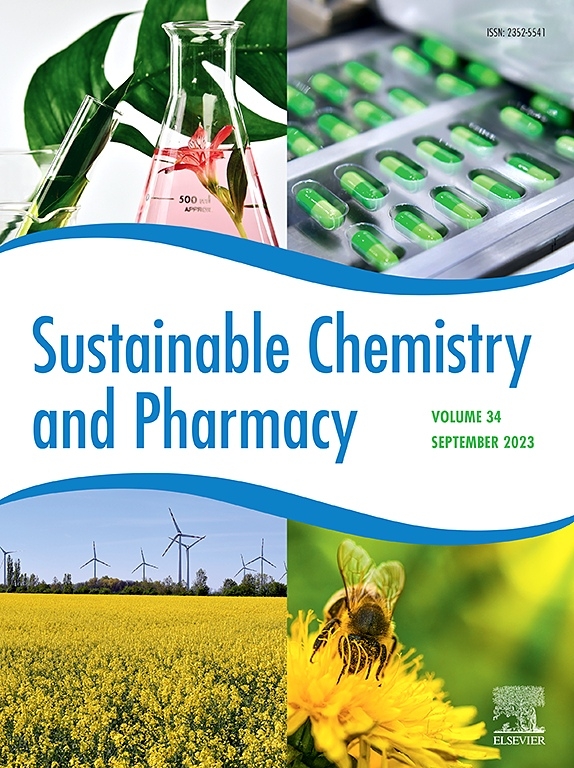Enantioselective extraction of ibuprofen enantiomers using quinine-terminated tetra-arm PEGs as a recyclable chiral selector
IF 5.5
2区 化学
Q2 CHEMISTRY, MULTIDISCIPLINARY
引用次数: 0
Abstract
A novel chiral quinine-terminated tetra-arm PEGs (Quin@4-arm PEGs) was synthesized from tetra-arm PEGs and natural quinine, demonstrating significant chiral recognition of ibuprofen enantiomers, as confirmed by NMR analysis. We have developed a biphasic chiral extraction system to separate the two enantiomers of ibuprofen using the as-prepared Quin@4-arm PEGs as the chiral selector. We explored several extraction parameters, including pH, chiral selector concentration, initial ibuprofen concentration, and temperature, to evaluate their influence on the enantiomeric excess and distribution behavior of the two enantiomers. The optimal conditions for the enantioselective extraction of ibuprofen enantiomers were determined using response surface methodology. The results showed that a single chiral extraction could achieve an enantiomeric excess of up to 54 % and a yield exceeding 80 % for S-ibuprofen at the initial ibuprofen concentration of 0.09 mg⋅mL−1, with 2.22 % Quin@4-arm PEGs, a pH of 7.6 and a temperature of 18.0 °C. In addition, back-extraction experiments demonstrated the effective recycling of the chiral selector in this chiral extraction system, achieving similar enantioselective extraction results over seven cycles. This work provides an effective method for separating ibuprofen enantiomers using quinine-terminated tetra-arm PEGs as a recyclable chiral selector.

用奎宁端四臂聚乙二醇作为可回收手性选择剂对布洛芬对映体的选择性提取
以四臂聚乙二醇和天然奎宁为原料合成了一种新型的手性奎宁端四臂聚乙二醇(Quin@4-arm peg),经核磁共振分析证实,该聚乙二醇对布洛芬对映体具有明显的手性识别。我们开发了一种双相手性萃取系统,以制备的Quin@4-arm聚乙二醇作为手性选择剂分离布洛芬的两个对映体。研究了pH、手性选择剂浓度、布洛芬初始浓度和温度等提取参数对两种对映体过量和分布行为的影响。采用响应面法确定了布洛芬对映体的最佳提取条件。结果表明,在初始布洛芬浓度为0.09 mg·mL−1,peg含量为2.22%,pH为7.6,温度为18.0℃的条件下,单手性提取s -布洛芬的对映体过量达54%,得率超过80%。此外,反萃取实验表明,手性选择剂在该手性萃取体系中有效回收,在7个循环中获得了类似的对映选择性萃取结果。本研究为利用奎宁端四臂聚乙二醇作为可回收的手性选择剂分离布洛芬对映体提供了有效的方法。
本文章由计算机程序翻译,如有差异,请以英文原文为准。
求助全文
约1分钟内获得全文
求助全文
来源期刊

Sustainable Chemistry and Pharmacy
Environmental Science-Pollution
CiteScore
8.20
自引率
6.70%
发文量
274
审稿时长
37 days
期刊介绍:
Sustainable Chemistry and Pharmacy publishes research that is related to chemistry, pharmacy and sustainability science in a forward oriented manner. It provides a unique forum for the publication of innovative research on the intersection and overlap of chemistry and pharmacy on the one hand and sustainability on the other hand. This includes contributions related to increasing sustainability of chemistry and pharmaceutical science and industries itself as well as their products in relation to the contribution of these to sustainability itself. As an interdisciplinary and transdisciplinary journal it addresses all sustainability related issues along the life cycle of chemical and pharmaceutical products form resource related topics until the end of life of products. This includes not only natural science based approaches and issues but also from humanities, social science and economics as far as they are dealing with sustainability related to chemistry and pharmacy. Sustainable Chemistry and Pharmacy aims at bridging between disciplines as well as developing and developed countries.
 求助内容:
求助内容: 应助结果提醒方式:
应助结果提醒方式:


